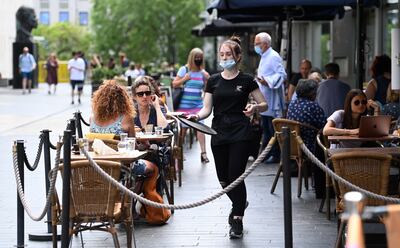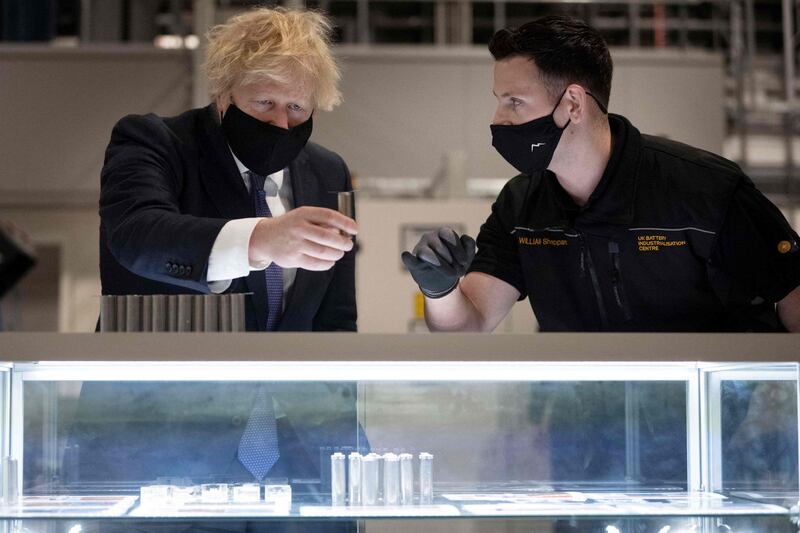British Prime Minister Boris Johnson pledged on Thursday to “level up” the economy by improving living standards across the UK amid a surge in hiring activity as the economy reopens.
Mr Johnson’s plan to boost living standards in the "forgotten" parts of Britain comes as unemployment fell to 4.8 per cent in June. The number of people on payrolls grew by 365,000 in the biggest increase since the start of the pandemic, according to the Office for National Statistics.
It means the number of vacancies surpassed pre-pandemic levels in the three months to June with 862,000 jobs on offer, 77,500 more than the first three months of 2020.
In a speech in the West Midlands, Mr Johnson said that his promise to level up the country – a key slogan during his 2019 election victory – will boost living standards, spread opportunity and improve public services in areas outside the traditionally prosperous London and South-East, according to 10 Downing Street.
“Levelling up is not a jam-spreading operation,” Mr Johnson said as he ruled out policies designed to simply transfer wealth from richer to poorer parts of Britain.
“It’s not zero sum, it’s win win,” he will say. His plans aim to relieve pressure on other densely populated parts of the country.
The British economy is dominated by London and the South-East, with a 2020 government report finding gaps in economic productivity between the capital and other regions of the UK as wide as they were in 1901.
However, the total number of people in work rose by 25,000 in the three months to May, with inactivity – those neither in work nor looking for a job – increasing by 71,000. That resulted in a 68,000 drop in the unemployment level.
Although payroll numbers are still 206,000 below pre-pandemic levels and a large number of workers are on furlough, some regions targeted by Mr Johnson’s levelling-up promise have already made up lost ground.
“We are bouncing back,” Chancellor of the Exchequer Rishi Sunak said. “The number of employees on payrolls is at its highest level since last April and the number of people on furlough halved in the three months to May.”
The rise in vacancies confirms the ongoing challenges around hiring workers as several sectors complain of staff shortages.
“The recruitment difficulties faced by firms go well beyond temporary bottlenecks. Staff shortages may drag on any recovery,” said Suren Thiru, head of economics at the British Chambers of Commerce.
The figures come a day after Bank of England deputy governor Dave Ramsden indicated that the surprise buoyancy in the labour market may lead officials to consider whether to withdraw emergency stimulus to keep inflationary pressures in check.
Wages, including bonuses, rose an annual 7.3 per cent in the three months to May, the fastest on record. The ONS, however, said the figures are being distorted by the pandemic.
The increase reflected depressed wages a year earlier, the loss of low-paid jobs and the return to full-time work of staff who were previously furloughed on just 80 per cent of their pre-pandemic salary. The ONS estimates that underlying pay growth is running at 3.9 per cent to 5.1 per cent.
Ruth Gregory, senior UK economist at Capital Economics, said revisions to past employment data indicates that there is “more slack in the jobs market than previously thought”.
“In April, employment was 899,000 lower than its pre-crisis level (586,000 before) and instead of drifting down to 4.7 per cent in April, the unemployment rate was 4.8 per cent," Ms Gregory said.
“So we still think there is enough slack in the labour market to keep a lid on underlying pay pressures.”
Ms Gregory said the labour shortages will prove temporary and that they will be confined to a few sectors, such as hospitality.
“So instead of monetary policy being tightened in mid-2022 as the markets expect, we think it will happen in early 2024,” she said.

While the unemployment is promising for the UK, with the number of employees on payrolls in June for the North East, North West, East Midlands and Northern Ireland above February 2020 levels, the government is still pushing ahead to with plans to bring more jobs and prosperity to areas around the former industrial towns in northern England.
Mr Johnson plans to even out the gap between the north and the south through higher spending on infrastructure.
"We don't want to decapitate the tall poppies," he will say in his speech in the West Midlands on Thursday.
"We don't think you can make the poor parts of the country richer by making the rich parts poorer."
Mr Johnson will say that previous governments directed investment into areas such as London and the South-East, where house prices were already high and transport congested
He hopes that by investing in areas with lower growth, people will not have to move to secure better jobs.
"We will have made progress in levelling up when we have begun to raise living standards, spread opportunity, improved our public services and restored people's sense of pride in their community," Mr Johnson will say.
Mr Johnson’s attempt to return public attention to his levelling -up plan comes as a new wave of the pandemic grows in the UK, with the country recording the highest number of new infections on Wednesday since January 15 .
The government is pushing ahead with plans to remove all coronavirus restrictions on July 19 despite the rise in case numbers.
Until now, Mr Johnson’s levelling-up pledge has been criticised for being too vague and poorly defined, with queries over how the government will pay for its plans, considering the country’s soaring debt levels during the pandemic.
The government is looking to invest in the green economy and attract foreign investment, moves that were given a boost in recent weeks by Nissan and Stellantis both looking to invest more in Britain, to build a battery plant and electric vans in the North-East and North-West of the country respectively.
Coventry Airport, in the West Midlands, is also vying to become the site for a gigafactory, while at a sustainable investment conference this week it was revealed that the UK and Saudi Arabia would “join hands” on clean energy innovation as the two countries look to boost trade and investment.
The next question for the economy is what happens when wage subsidies for furloughed workers end on September 30.
Almost 2.4 million jobs were still receiving the benefit at the end of May, with many people currently supported likely to find themselves out of work come the autumn.
“As the furlough scheme winds down, it is likely that not all workers will be absorbed back into the labour market immediately,” said Yael Selfin, chief economist at KPMG UK.
“We anticipate the unemployment rate to rise to about 5.5 per cent in winter this year as the furlough scheme ends.”






